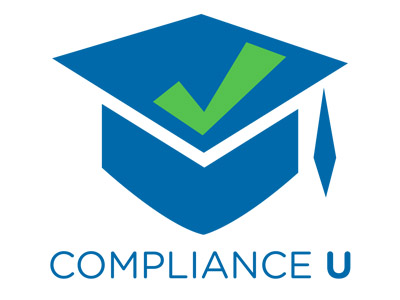 |
Equal Opportunity 101 (Corrections) |
0.17 |
The U.S. Department of Labor Civil Rights Center is committed to providing clear and easy-to-access information on how to comply with federal equal opportunity and nondiscrimination laws and regulations that (1) prohibit discrimination in DOL-funded programs and activities, and (2) prohibit discrimination on the basis of disability by certain public entities and in DOL-conducted activities. This course is a brief overview on equal opportunity rights. |
 |
Video Analysis: Activities and Events |
1.00 |
The video-data for your inquiry project has been collected, now what? Testing your hypothesis is usually a dance, back and forth between the "ideal" and "reality-check". Listen to a research team decide how they will analyze video-data to extract just the information needed to focus on the inquiry questions. The first step is to sort video clips by activity categories, then score each clip using a recording protocol defined in terms of counting behavioral events and/or time sampling of activity states. |
 |
Careers Without College |
1.00 |
There are many different ways to be successful in life. What might be the right career path for some may not be the right choice for you. Finding your niche is important. When selecting the right career path, it’s important to weigh all of your options. In this course, we will explore a wide range of careers available to anyone with various skills and a high school education.
|
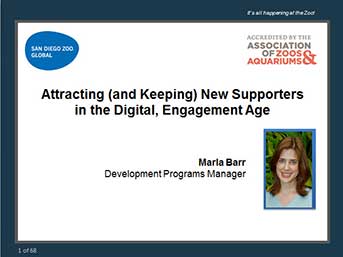 |
Attracting (and Keeping) New Supporters in the Digital, Engagement Age |
1.00 |
There are more non-profits in the market every day, but less donors. Is this a recipe for disaster, or an opportunity for us to transform what donor acquisition, retention and stewardship look like in our digital age? Join us during this 60 minute webinar to learn what innovative donor engagement in 2013 looks like by walking through some of the San Diego Zoo Global's recent digital campaign hits and misses to see how you can help your organization rise above this changing donor landscape. |
 |
Anti-Discrimination Law: A Primer for Small Businesses |
0.75 |
There are multiple federal laws regarding discrimination in the workplace.
Beginning with the Civil Rights Act of 1964, the U.S. Congress has passed a number of laws to address various forms of discrimination. The Fair Housing Act of 1968, for example, prohibited discrimination concerning the sale, rental, and financing of housing based on race, religion, national origin, sex, (and as amended) handicap (later called disability), and family status. In 1990, the Americans With Disabilities Act (ADA) was passed to protect the rights of individuals who are differently enabled, physically or mentally. Other laws, or amendments made to existing laws, provided further protections for people with disabilities, workers over the age of 40, and LGBTQ+ individuals, among others.
The purpose of this course, however, is not to give a history lesson on U.S. anti-discrimination law but to focus on how those laws apply today to small businesses, their employees, and their customers. |
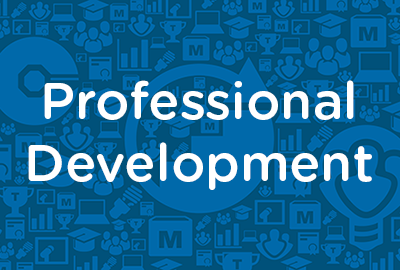 |
Cross-Cultural Business Communication: Overcoming Communication Barriers |
1.00 |
There are several barriers that can affect cross-cultural communication. Generally, barriers have a negative effect on communication because they might distort the speaker’s message or the listener’s understanding. It is important to understand these barriers to communicate effectively with people from different cultures.
In this course you will learn to: identify common cross-cultural communication barriers, overcome communication barriers and avoid cultural bias, and employ qualified interpreters and communicate through them. |
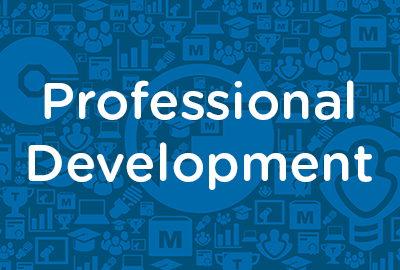 |
Cross-Cultural Business Communication: Overcoming Communication Barriers (Instructor Guide) |
1.00 |
There are several barriers that can affect cross-cultural communication. Generally, barriers have a negative effect on communication because they might distort the speaker’s message or the listener’s understanding. It is important to understand these barriers to communicate effectively with people from different cultures.
In this course you will learn to: identify common cross-cultural communication barriers, overcome communication barriers and avoid cultural bias, and employ qualified interpreters and communicate through them.
This Instructor's Edition of this course includes notes and suggestions to assist you in presenting the material, whether in an in-person classroom setting, or as an instructor-led online or distance-learning course. It also provides you with the answers to questions found in mid-lesson activities, as well as in the quiz that concludes the course. |
 |
Lifting and Moving—Lesson 1 |
0.50 |
There are several disciplines of healthcare that require proficiency in lifting and moving. Prehosital medicine and fire-service-related rescue requires a proficiency in this area that is beyond any other area of healthcare. Our team of experts discuss the challenges that we face in our community. In this first session of the series, we explore the mindset and preparation that must take place in order to achieve success.
Final Exam:This multiple choice exam is designed to test your knowledge of the material you just reviewed. You have two attempts to gain a 70% or higher on this exam. Please take your time and answer each question carefully. |
 |
E-Mail Etiquette: E-Mail Policies |
0.75 |
There is an unprecedented amount of documented information available today. An offensive or improper e-mail sent to one person can be copied and sent to many users. It’s important that employees familiarize themselves with and follow their organization’s e-mail policy because employers can be held liable for employee e-mail use. |
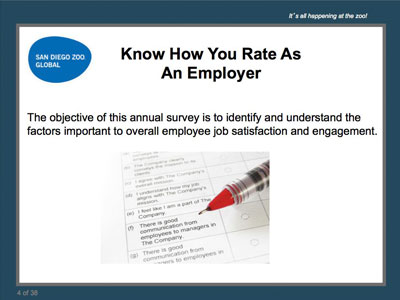 |
Effectively Managing an Employee Engagement and Satisfaction Survey |
1.00 |
There is much scientific evidence that clearly shows a direct correlation between employee engagement/satisfaction and organizational performance. Engaged employees are more productive, profitable and customer service oriented. Engaged employees drive company innovation and have increased tenure. Learn how to conduct a World Famous Employee Satisfaction Survey, and incorporate the right questions to ask to also measure Employee Engagement - which will definitely benefit your organization by showing employees that you have a genuine interest in their feedback. |
 |
Presentation Methods and Debriefing Activities |
2.00 |
There is no "one size fits all" approach to working with children and youth, and this is especially true when it comes to how we present and debrief activities. During this course, participants will understand the importance of the delivery and debriefing of an activity to help children and youth make meaning, as well as some specific methods that can be incorporated into the program right away. |
 |
Internet Safety |
1.00 |
There's almost no limit to what you can do online. The internet makes it possible to access information quickly, communicate around the world, and much more. Unfortunately, the internet is also home to certain risks, such as malware, spam, and phishing. If you want to stay safe online, you'll need to understand these risks and learn how to avoid them. |
 |
Constructing: Airway Essentials—Part 8 |
0.50 |
These eight Airway Essentials Lessons conclude with Dr. Christopher Galton's thoughts on what should be done after the ALS airway has been established. It is here that ideas are offered on what paramedics should read and learn more about to improve their practice. Grab a pencil and a notepad and get ready to graduate from the EMS Plumbline "Introduction to ALS" to the "Paramedicine" Division. Final Exam: This multiple choice exam is designed to test your knowledge of the material you just reviewed. You have two attempts to gain an 80% or higher on this exam. Please take your time and answer each question carefully. |
 |
Connecticut Sexual Harassment Prevention Training |
2.00 |
This 2 hour Connecticut Sexual Harassment Prevention Training is brought to you by the Connecticut Commission on Human Rights and Opportunities.
Thank you to the Connecticut Commission on Human Rights and Opportunities' for allowing us to use their materials from the Sexual Harassment Prevention Training course. |
 |
Introduction to Risk Management |
1.00 |
This an introductory course that introduces the firefighter to the concepts of risk management. The concepts introduced in this course are intended to create a healthy attitude regarding safety and begins a process of developing a safety-minded culture. The definitions of hazard and risk are defined and the concept of risk management is explained. This explanation of risk management is intended for firefighters who need a rapid and effective method for identifying and mitigating dangers on the fire ground. |
 |
Mental Health - Anxiety Overview |
1.00 |
This brief overview of the topic of anxiety disorders explores the assessment and treatment that EMS providers should be familiar with. Along with the intricate evaluations that EMS providers must obtain on the patients they are caring for there is the underlying issue of evaluating ourselves. This tour of the topic will certainly offer opportunities for EMS providers to assist responders and patients alike.
Exam Description Please read each question carefully. You will have two attempts to gain a 70% or higher on this exam. If you are not successful in two attempts you are welcome to take the course again to gain the certification. Best of luck! |
 |
Working with Minors |
2.00 |
This collection includes Reporting and Abuse Laws, Campus Policies, Developmental Differences and Establishing Boundaries. |
 |
Great Apes |
3.00 |
This collection of 3 courses explores the natural history and conservation of the great apes and covers a bit about primates and how the apes fit into this larger group of animals. |
 |
ALS Airway Response - Part One |
1.00 |
This conversation with Dr. Christopher Galton turns into a lesson that any paramedic (no matter what their background) will find beneficial in their attempt(s) to improve their Airway Skills. Dr. Galton, leads this discussion by bringing together his experiences in the pre-hospital arena, the emergency department, the ICU, the operating room, and beyond. Pull out a pen and paper and get ready to write down talking points that you will undoubtedly debate with fellow paramedics. You have two attempts to gain a 70% or higher on the exam. Take your time and good luck! |
 |
Preventing Violence at the Workplace - Retail |
0.50 |
This course addresses workplace violence, including its factors and types, and provides strategies for preventing it. |
 |
Trauma-Informed Practices |
1.00 |
This course contains an overview of trauma: what it is, how to manage it, and what it looks like for students; a list of trauma-informed practices; and ways to ensure that you are implementing data-driven trauma-informed practices.
Trauma-Informed Practices is just one out of two courses in our trauma series. Be sure to check out the other course, Trauma and Its Impact on Education. |
 |
Cultural Diversity in School Settings |
1.00 |
This course contains definitions of diversity, equity, and inclusion (DEI) and the role DEI plays in the school setting. Embracing diversity, equity, and inclusion benefits everyone within a K-12 institution: faculty, staff, students, and families.
Learners will reflect on the different elements of their own identity and how that impacts their perception of others. This course will also discuss the role of bias in the school setting. |
 |
Digital Photography |
1.00 |
This course covers a basic understanding of digital photography, the techniques that can be used to make photos better, and the different uses for cameras. |
 |
Overview of Enforcement for Occupational Exposure to Tuberculosis (TB) |
0.50 |
This course covers a brief overview of OSHA’s enforcement policy for occupational exposure to tuberculosis. OSHA’s tuberculosis policy is found in CPL 02-00-106 – CPL 2.106 – Enforcement Procedures and Scheduling for Occupational Exposure to Tuberculosis. |
 |
Robert's Rules of Order |
1.25 |
This course covers a general understanding of Robert's Rules of Order, the gold standard for facilitating discussions and group decision-making. Ideal for individuals involved in organizational leadership, community boards, and other decision-making groups, it is just one of many courses we offer. |


























